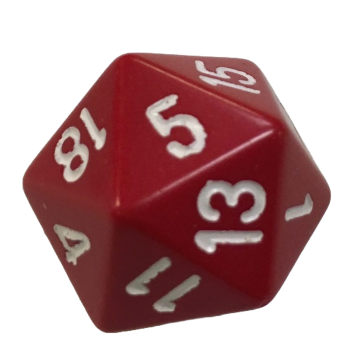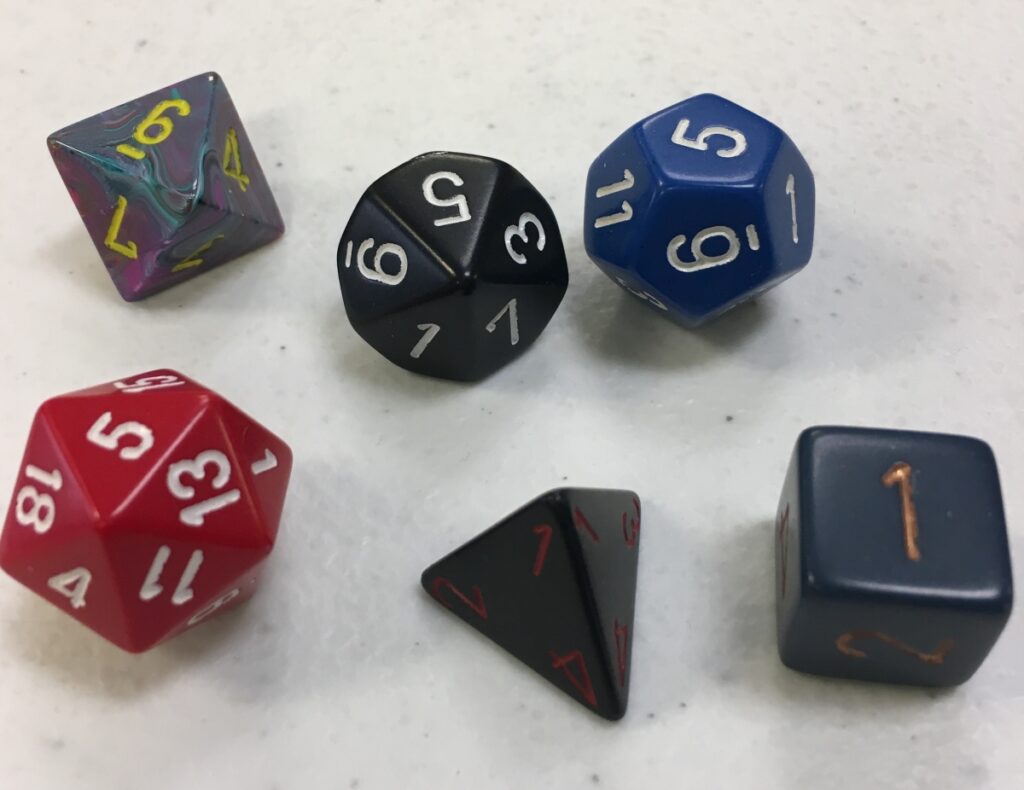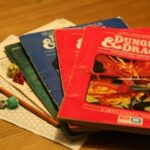
Dice are used in games around the world to generate a random number. Traditionally the die is cubical; however there are multiple forms of non-cubicle die, such as, the 20-sided die. Ancient die were typically made from bone, wood, or stone. Today, die of all shapes are usually made from resin. The 20-sided die can be traced back to the Romans, however this ancient tool for generating numbers was put to a new purpose in 1974 in Lake Geneva, Wisconsin. In that year Gary Gygax incorporated the 20-sided die into a new game he had invented.
That game was called Dungeons & Dragons.
Before adopting the die, Gygax’s now-famous game asked players to randomly draw numbered poker chips from a bag. This method was cumbersome, limited the game’s portability, and was not sufficiently random. Gygax adopted the new die because the shape of the 20-sided die offers an equal five percent probability for each outcome. The more commonly used six-sided cubical dice do not offer equal probability and are relatively predictable in their results. With two six-sided die, for instance, rolling a 6, 7, or an 8 is frequent, while 2’s and 12’s are rare. This does not create equal probability in a combat with monsters!
In his fantasy-based tabletop game, Gygax introduced Americans to a new kind of role-playing game where all players needed was the rule book, seven types of dice, pencil, paper, a sheet of graph paper, and their imagination. Players create their own personas, endowed with characteristics achieved by a roll of a die. Once the brave companions have started their adventure, the 20- sided die became the most important die used in the game. That die controls the strategies and attacks made by players; an ancient tool put to new uses!
Written by Mallory Zink, June 2018.

Sources
Galen Druke, Rob Ferrett, Ethan Gilsdorf, and John Kovalic, “The Influence And Wisconsin Origins Of Dungeons and Dragons,” Central Time, Wisconsin Public Radio. 20 January 2014. https://www.wpr.org/shows/central-time/lessons-learned-dying-civil-rights-wisconsin-dungeons-and-dragons/.
Ethan Gilsdorf, “Dungeons & Dragons: 40 Years Of A Wisconsin Invention,” Central Time, Wisconsin Public Radio. 20 January 2014. https://www.wpr.org/shows/central-time/lessons-learned-dying-civil-rights-wisconsin-dungeons-and-dragons/.
David Kusher, “Dungeon Master: The Life and Legacy of Gary Gygax,” Wired. 10 March 2008. Accessed December 2017. https://www.wired.com/2008/03/dungeon-master-life-legacy-gary-gygax/.
Anne Morrissy, “Dungeons & Dragons: A Journey of Imaginations,” At the Lake: Geneva Lake Area Magazine. 25 November 2014. Accessed 21 December 2017. https://atthelakemagazine.com/dungeons-dragons/
Joy Powers, “Exploring Dungeons & Dragons’ Wisconsin origin-story on its 50th anniversary,” Lake Effect, WUWM. 25 September 2024. https://www.wuwm.com/2024-09-25/exploring-dungeons-dragons-wisconsin-origin-story-on-its-50th-anniversary/.
Riley Silverman, “What Is Dungeons & Dragons?” D&D Beyond (blog). 31 March 2023. https://www.dndbeyond.com/posts/1480-what-is-dungeons-dragons/.
Learn more about the history of the 20-sided die and role playing game Dungeons and Dragons in this short video. Click on the video title to open in YouTube for captions.



